Wake Boarding, Wake Surfing, Waterskiing or Tubing -- Which Boat is Best?
With hundreds of sportboat and runabout models on the market from scores of builders, making a decision as to which boat to buy can be difficult. Throw in the fact that there are four distinctly different types of boat in this category -- sterndrive, outboard, jet drive, and inboard powered -- and the fact that different watersports are best done with certain boat configurations, and you begin to see the magnitude the of problem. Making a decision among sportboats between one boat and several others is often perplexing for even long-time boat owners.
But like virtually all things in boating, if the "mission" of the boat is narrowly defined, then the decision becomes much easier. Most boats are built primary for one or two specific activities and other uses for the boat are tertiary. By first identifying what your primary goal for your new boat is, and then by finding out what the builder's intention was when he designed the boat, sportboat buyers can zero-in on a short list of models that will meet their needs.
Adding a price-point consideration creates yet another dimension to the search for the best boat for any given need and purse. Then there is the matter of warranty and aftermarket customer service. But before drilling down to those details, you must get the type of boat selected first. This week Seattle yacht broker Martha Comfort provides us with installment #6 in a series of articles on boat buying.
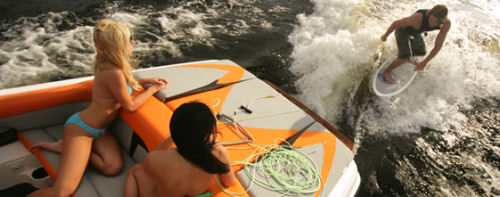 Wake surfing is the latest variation on the wakeboarding theme and dudes are taking up the challenge all over the world. |
Stern Drive Sportboats
Most people started skiing behind general purpose sportboats or runabouts, either powered by a stern drive or outboard engine. These boats are fine for most casual boaters or beginners and can be used for all sorts of things including cruising, swimming, fishing and just hanging out. Annually anywhere from about 35,000 to 70,000 of these boats are sold in the U.S. Most of these boats are sterndrives, but there are now a few models being offered that are outboard-powered, as well.
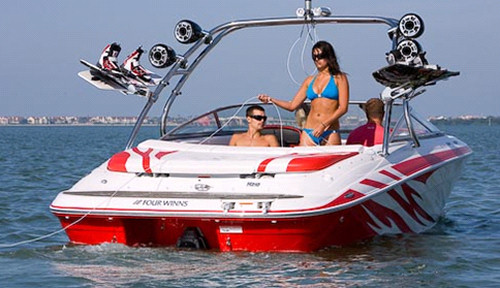 Increasingly traditional builders of sterndrive sport boats are delivering all of the amenities of the specialized ski/wake builders. |
During the last ten years or so, more and more builders of sportboats have been fitting their products with optional towing arches allowing tow ropes to be placed at the pivot point of the boat instead of on the transom. This has broadened the appeal of sportboats, even though they are virtually all sterndrive-powered boats which are not known for a flat wake desired by skiers.
Also for the last decade more and more builders have been extending the swim platform on the stern of their sportboats. This has made it easier for enthusiasts to put on their skis and wake boards, and because these longer platforms usually extend beyond the sterndrive lower unit they make it easier and safer to slip into the water without being cut by the prop or lower unit.
Traditional sport boat builders have been upgrading their boats in other ways, too, to make their products more appealing to the wake dudes and dudettes who are becoming a bigger segment of the market. For example, boss stereo systems are being installed on some models, with enough power to wake up the local town council. Also, new seating arrangements have been introduced on some models to replicate “stadium seating” for the wake boarders’ cheering fans.
Most small sportboats are designed for protected water, which means lakes, rivers, small estuaries and bays. Larger sportboats are often capable of handling bigger water, but remember, you will want fairly flat water for your watersport activities no matter where you go boating.
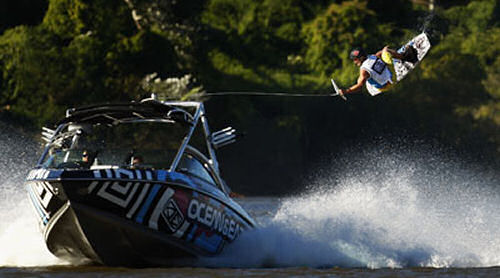 Note the towing arch is placed on the pivot point of the boat and gives height to the rope, making spectacular jumps possible. |
Specialized Boats
As hard as traditional sportboat builders have been working to appeal to the new breed of watersport enthusiast, six to eight builders have specialized in ski and wake boats for decades and their boats are hard to beat for these specific missions. Virtually all of these boats are inboard powered. Each year there are from 6,000 to 12,000 specialized boats for skiing and wakeboarding sold by these U.S. builders to connoisseurs of this category of ski/wake boat. These builders make boats exclusively for these watersports and make no attempt, for the most part, to appeal to fishermen, sunbathers, or hot shots who want to blast around faster than any other top gun on the lake.
These specialty inboard boats are carefully designed for action off the stern. Typically in this genre, the fit-and-finish is superb and few expenses are spared in materials and workmanship. Buyers of these boats tend to be more experienced boaters who know what they want to do, and also understand that the quality of the product that they are getting is going to cost a lot more than the standard sportboat.
 Over the years specialized ski/wake boats have gotten bigger and more versatile. Note the location of the towing arch on this 24-footer and you can almost hear those four large speakers. |
Jet Boats
For the last decade jet boats have been increasing in popularity, and about 5000 to 7000 are sold in the U.S. in any given year. While one might think that these buyers are coming from PWC owners trading up, in fact most of the buyers are coming from traditional sportboats. Jet boats are famous for getting on plane faster than virtually any other boat in the size range. That, together with the fact that they produce a large wake, particularly if their stern is loaded, make them a prime candidate for casual wakeboarders. On the other hand that wake makes them less popular with skiers. Tubers also will like the jet boats, as well as PWCs, which are now very much in the mix for towing tubers.
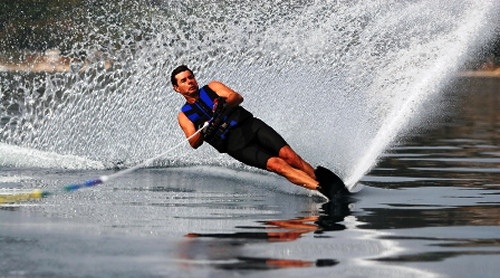 Slalom skiers like flat wake so they can carve their turns. |
Ski or Wake?
Typically, ski boats are small, light, throw little wake and are highly maneuverable with a small turning radius. For the last 10 years or so the ski boat builders have been modifying and adapting their existing ski boat designs for wakeboarding. This has been somewhat difficult because wakeboarders want high wakes which is just the opposite of what the skiers want.
The result has been the addition of tabs and wedges to the transom of some models of these boats to help create wake. Also, ballast tanks to sink the stern further into the water to create more wake have become standard equipment on many models. Some builders are moving their engines to the stern and using V-drives to get the best of both worlds -- weight in the stern for wake, but the prop under the boat for safety.
 This specialized ski boat has the engine in the stern and a V-drive, a towing arch and a towing pylon in the stern of the boat. Note the rack for wakeboards which means this boat is used for both sports. |
Inboard Power
Virtually all boats built specifically for skiing and wakeboarding have a single inboard engine. Inboard boats generally have their propellers several feet forward of the transom, and as a result the vortex of the props’ thrust that goes up hits the bottom of the boat and is flattened out by the time it exits from under the stern. Because sterndrive boats have their props close to the surface of the water some thrust is directed up as well as aft and down, which adds to the boats natural wake.
Traditional inboard boats also have their engines placed amidships, usually in the middle of a large, open cockpit. This placement serves a number of purposes. First, the engine is far enough forward that the props are under the bottom of the boat well forward of the transom. This translates to increased water safety.
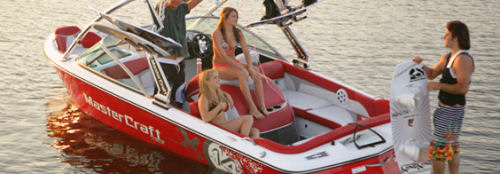 This boat has the traditional placement of the inboard engine in the middle of the cockpit. |
Second, it moves weight forward so the stern is not weighted down, thereby creating less wake which is desirable for skiers. There are a number of other advantages of having the engine in a box forward, such as being able to easily reach everything for repair and maintenance.
Over time several small engine marinizers began specializing in ski boats. They optimized engine and tranny performance for fast hole shots and economy in the speed ranges preferred by most skiers, and did not go for the high top-end speed as is wanted by most sportboat builders.
Inherent Safety
Because the propeller of an inboard boat is under the boat and not abaft the transom, inboard boats have a definite safety advantage. Even if an inboard engine is left on or even in gear while a skier is in the water at the stern, there is unlikely to be an injury.
Skiing tournament rules were promulgated decades before the advent of the sterndrive was invented in the late 1950s, and as a result in virtually all high-level competition skiing events only approved inboard-powered boats are used. This not only levels out the wake, but also the “playing field” so that judges can focus solely on the artistry and skill of the skier.
 It’s all about getting big air like this wake dude on Lake Como, Italy, our most favorite lake in the world. |
Wake Riders
Wakeboarding has been the most energizing pursuit to hit the boating world in decades. It was only natural that wakeboarders would come from the ranks of snowboarders (who came from roller boarders) and these aficionados are both young and tuned into the specialized skiboat brands. These builders -- faster than any others -- realized how big wakeboarding could get and quickly did whatever they could with their inboard boats to induce more wake. Today wakeboarding has taken root, surpassing skiing as an activity both in terms of thrills and chills, but also in sheer numbers, as well.
Even today most ski/wakeboard boats on the market are hybrids, originally designed for skiing but now equipped with devices to create wake. With each passing year, more and more of the specialty ski and wakeboard builders are introducing models that are designed from the beginning to maximize wake. We expect to see even more of them in the future, particularly as the latest wrinkle --wake surfing -- picks up momentum.
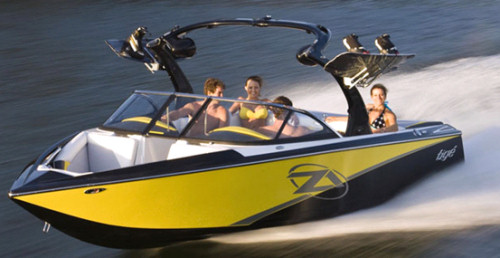 This boat is set up with a stern that can sink down with ballast for even higher wakes. |
Limitations of Specialized Boats
These specialized ski/wakeboard boats do not "cross over" well into other recreational activities. Ski boats are generally small and their focus is behind the boat where all of the action is and not in front of it. They are also designed to operate in flat, protected water, such as that found on small lakes where most competition skiing events take place.
Generally these boats have low freeboard and low, often droopy bows which do not make them good candidates for big lakes or many saltwater locations, where general-purpose sportboats are often better suited. Specialized ski/wakeboard boats usually cost more than do production runabouts or sportboats.
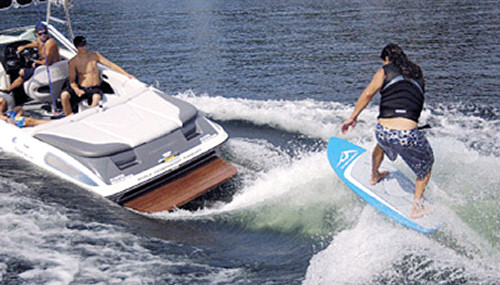 Only inboard boats should be used for wake surfing for the obvious reason shown here. |
Wake Surfing
RULE #1: Only wake surf behind an inboard-powered boat! Don’t even think about doing it behind a sterndrive or outboard-powered boat. If you see someone breaking this rule, drop whatever you are doing and beg them to stop. The sport requires the surfer to be entirely too close to the stern of the boat for safety if a propeller is there.
While jet boats are safe in this respect, because of the nature of their thrust they are not recommended for wake surfing. Wake surfing also requires an experienced and skilled boat driver and good communication between the surfer and the spotter. This is a sport for the specialized inboard ski/wake boats only.
 This is our favorite tubing picture. It explains better than anything we could say about why kids love tubing so much. |
Tubing
Tubing is the least specialized of all the water sports we are discussing, and because it appears to require little skill for the rider besides hanging on, it is the most popular of all four of these watersports. Surprisingly, while people towed car inner tubes 75 years ago, it was not until relatively recently that all of the spectacular plastic tubing products were developed. They come in all shapes and sizes and hold anywhere from one to six or more riders.
Because tubing looks so simple most participants do not realize that it can be dangerous just like any other watersport. The operator of the tow vehicle must be careful not to swing the tuber into an obstruction or another boat. The person being towed must be aware of what is going on in front and to the sides and take preventative action if something looks amiss. Virtually any boat -- even PWCs -- can tow a tube, so the emphasis here is less on the type of boat employed and more on the experience and skill of the person driving the tow boat.
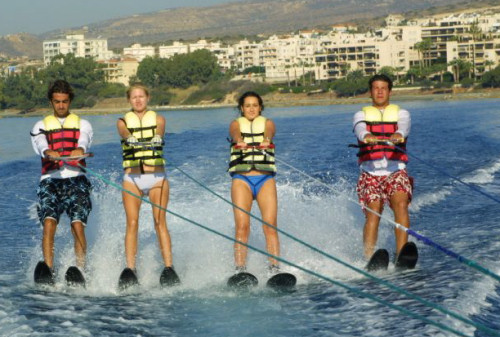 It takes a lot of power and torque to get four skiers up at once. Make sure your engine is up to the job and your boat is correctly propped. |
Horsepower Matters
In all cases, you will want a boat with a fast 0-to-plane hole-shot time. The longer it takes a boat to reach planing speed without a tow (which is how BoatTEST.com tests boats) the harder it will be for the participant to get up on the skis or wakeboard. Skiing and wakeboarding require strength and the slower the planning time the stronger and more skilled must be the person being towed.
The boat’s horsepower is important. If you decide that you only want to pursue your watersports in a casual sort of way, or that your budget is limited, and that a conventional sportboat will fit your needs, then make sure that it has enough horsepower to get the job done. Many entry-level sportboats come standard with 3.0L engines developing 135-hp at maximum-rated rpm. This is the smallest engine generally used in sterndrive sport boats because it keeps down the price of the boat.
 The bow on this boat is called a pickle fork design and it is designed to add room in the bow for a large party. |
A 3.0L engine might be enough power to bomb around the lake with two or three people aboard in a 17-footer, or for casual cruising and tubing, but be woefully lacking for more strenuous work. If you want to ski or wakeboard, particularly if the participant is not experienced or you want to carry a large crowd of people aboard, then chances are you will need a larger engine.
Power for the Glory
The next largest is a 4.3L engine with about 190-hp. A 5.0L engine with 220-hp or more is an even safer bet if your boat is going to be loaded down and working hard. Remember, an under-powered boat -- no matter what the brand -- is the worst boat you can have. One of the most often heard remarks among the sportboat owners filling out BoatTEST.com’s “Owners’ Reports” is the lament that their boat is under-powered.
Generally speaking, the specialized inboard ski and wake boats are all adequately powered. Their buyers are not looking for the lowest price, and the builders would not risk the reputation of their brand with an underpowered boat. Typically the smallest engine these companies offer is a 5.0L engine developing 250-hp and up. It is not uncommon to see these boats powered by engines developing 375-hp. With that kind of power the engine will deliver lots of torque at the low end where skiers and wake boarders need it.
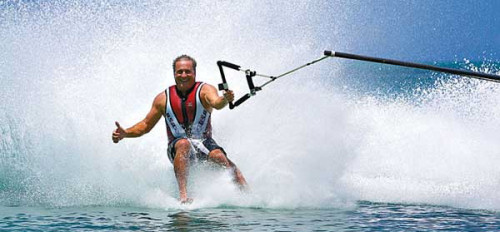 Bare-footing is for the fortunate few who have the skill, strength and boat to pull it off. |
Making the Choice
First, decide which water sport you want to pursue or if you want to enjoy them all. Second, decide if you want to enter ski or wakeboard tournaments, or would rather casually enjoy these sports with family and friends. Obviously, if you want to wake board you should have a boat that makes a large wake. If you only want to ski, then do you demand a flat wake or can you make the best of a boat with a wake? (People have been happily skiing behind sterndrive boats since 1957.)
When buying a boat for skiing or wakeboarding, decide where you belong on the activity level continuum, what body of water you will do your boating on, and how much is your budget -- or your Mom and Dad's budget. By embracing the guidance given above, by now you should know whether you belong in a sportboat, a jet boat or a specialized ski/wake boat and what the horsepower should be.
Good hunting.
About the Author—
 Martha Comfort |
(Martha Comfort has been boating since she was a young girl, has cruised extensively in the Caribbean, has been a USCG-licensed captain and has crossed the Pacific Ocean in a 36’ sailboat. She has been in the marine business for over 30 years, was Director of the Pacific Seacraft Yachting Center and Keppel Marina for 5 years in Singapore, has founded and sold two successful international marine dealerships. She holds the Certified Professional Yacht Broker C.P.Y.B. rating. She serves on numerous marine committees and currently chairs the Government Affairs Committee of Northwest Marine Trade Association. She has helped hundreds of new and experienced boaters select, buy and re-sell their yachts and is currently a broker for Chuck Hovey Yachts in Seattle, where she has been the last 12 years. Martha is the author of The Boat-Buying Handbook, which has been in print for eight years.)